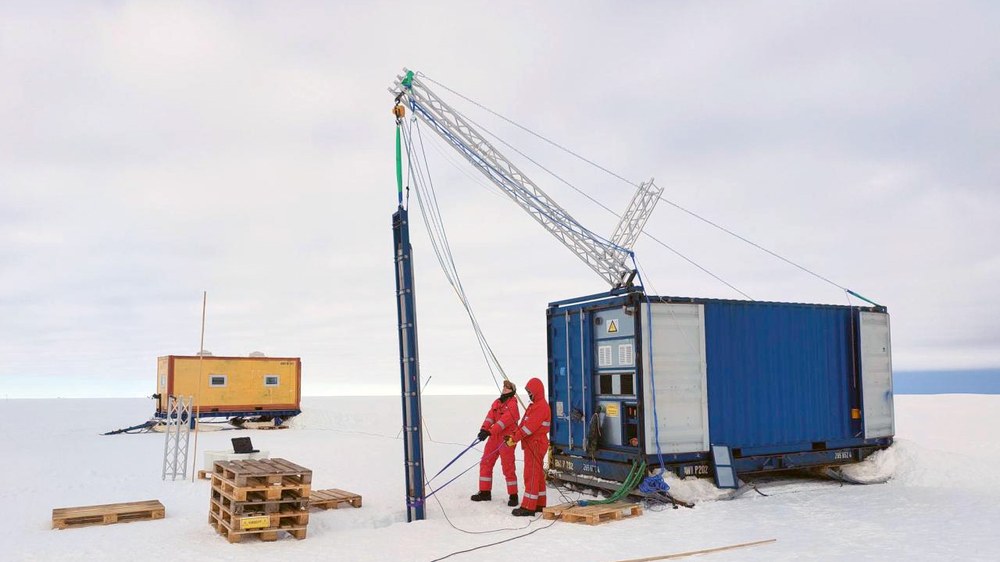The TRIPLE exploration system
TRIPLE-IceCraft melts into Antarctica’s Ekström Ice Shelf
In the TRIPLE-IceCraft project, GSI GmbH from Aachen and RWTH Aachen University developed a melting probe that can melt its way through a layer of ice more than 100 metres thick. The probe is approximately four metres long and has a diameter of roughly 20 centimetres. TRIPLE-IceCraft moves through the ice at a speed of several metres per hour, while remaining connected to the surface at all times by an umbilical cable integrated into the probe.
The probe has a melting head at each end and panel heaters on its side walls. Its functions are monitored using sensors that measure pressure, speed and temperature, and are controlled by a service system. The melting channel created by the probe freezes over again behind it. This is by design, in order to avoid contamination of the body of water beneath the ice by exposing it directly to the surface.
The supply cable must be integrated into the probe so that it can remain mobile even if it is frozen within the ice. During the melting process, it slowly unwinds from a cable spool. When the probe reverses to return to the surface, it pulls itself up again using the cable.
In February 2023, TRIPLE-IceCraft was tested in Antarctica by a team of researchers and engineers. At the Neumayer Station III of the Alfred Wegener Institute (AWI), the probe melted to a depth of 25 metres into the Ekström Ice Shelf. It carried a payload consisting of a camera and an acoustic navigation system.
The small underwater robot and biology laboratory
The first full system field test of the TRIPLE system on the Antarctic ice shelf is planned for 2026. During the test, the TRIPLE-IceCraft probe will descend into the ocean below, this time equipped with the nanoAUV small autonomous underwater vehicle and the launch and recovery system (LRS). The nanoAUV will be released into the water by the LRS using a robotic arm with a ‘soft robotic’ gripper, which will then also be used to ‘capture’ the vehicle again at the end of the mission.
Due to the small size of the nanoAUV, it requires special sensor, control and drive technology that can be accommodated in the smallest of spaces. An onboard navigation system equipped with artificial intelligence was designed to allow the vehicle to locate and travel to interesting locations and carry out fully autonomous sampling. The recovery system also needs to be specially developed to handle the diving robot. Anchored to the underside of the ice, the melting probe acts as an underwater base of operations. The nanoAUV will return to the probe after sampling to transmit the obtained data and charge its batteries.
The data are then sent from the base of operations to the surface, where they can be analysed immediately. After the exploration system has been recovered, the samples taken with the nanoAUV can be analysed in the small laboratory, the AstroBioLab. The fluorescence of microorganisms and the turbidity and content of dissolved oxygen in the water can be determined here. All analysis is carried out on site, so there is no risk of contamination.
Into the unknown with TRIPLE-IceCraft II
Following the first field test, the next step for the TRIPLE exploration system is planned for 2029. At this point, an optimised melting probe will melt its way through several kilometres of ice sheet in Dome C region of the Antarctic plateau. Its destination is a lake below the surface that has been closed off from the outside world for approximately one million years. In addition to the nanoAUV and LRS, the probe’s payload will also include the AstroBioLab, which will allow samples to be analysed immediately while still in the lake, beneath the surface of the ice.
Searching for life in space
Oceans and lakes enclosed beneath ice masses do not only exist on Earth. Missions such as Cassini-Huygens and Hubble have shown that there are enormous masses of water beneath the icy surfaces of distant celestial bodies such as Saturn’s moon Enceladus and Jupiter’s moon Europa. As far as we know today, water is a prerequisite for the emergence of life, which is why these regions are particularly interesting in the search for extraterrestrial organisms. The long-term goal of the TRIPLE exploration system is to make the technologies and components developed in the project available for future space missions.
Cross-disciplinary research collaboration across Germany
The TRIPLE project is based on an initiative by the German Space Agency at DLR and is funded by the Federal Ministry for Economic Affairs and Climate Action (BMWK). The individual components of the exploration system are being developed and built by 13 universities, research institutions and industrial partners from across Germany. GSI GmbH from Aachen is responsible for creating the TRIPLE-IceCraft II probe. The onboard computer technology is manufactured by DSI Aerospace Technologie GmbH from Bremen. Other contributors to the project include the Berlin-based companies EvoLogics GmbH (nanoAUV, LRS) and GloMic GmbH (radar technology for the probe melting head) and Rastede-based TriOS Mess- und Datentechnik GmbH (AstroBioLab).



